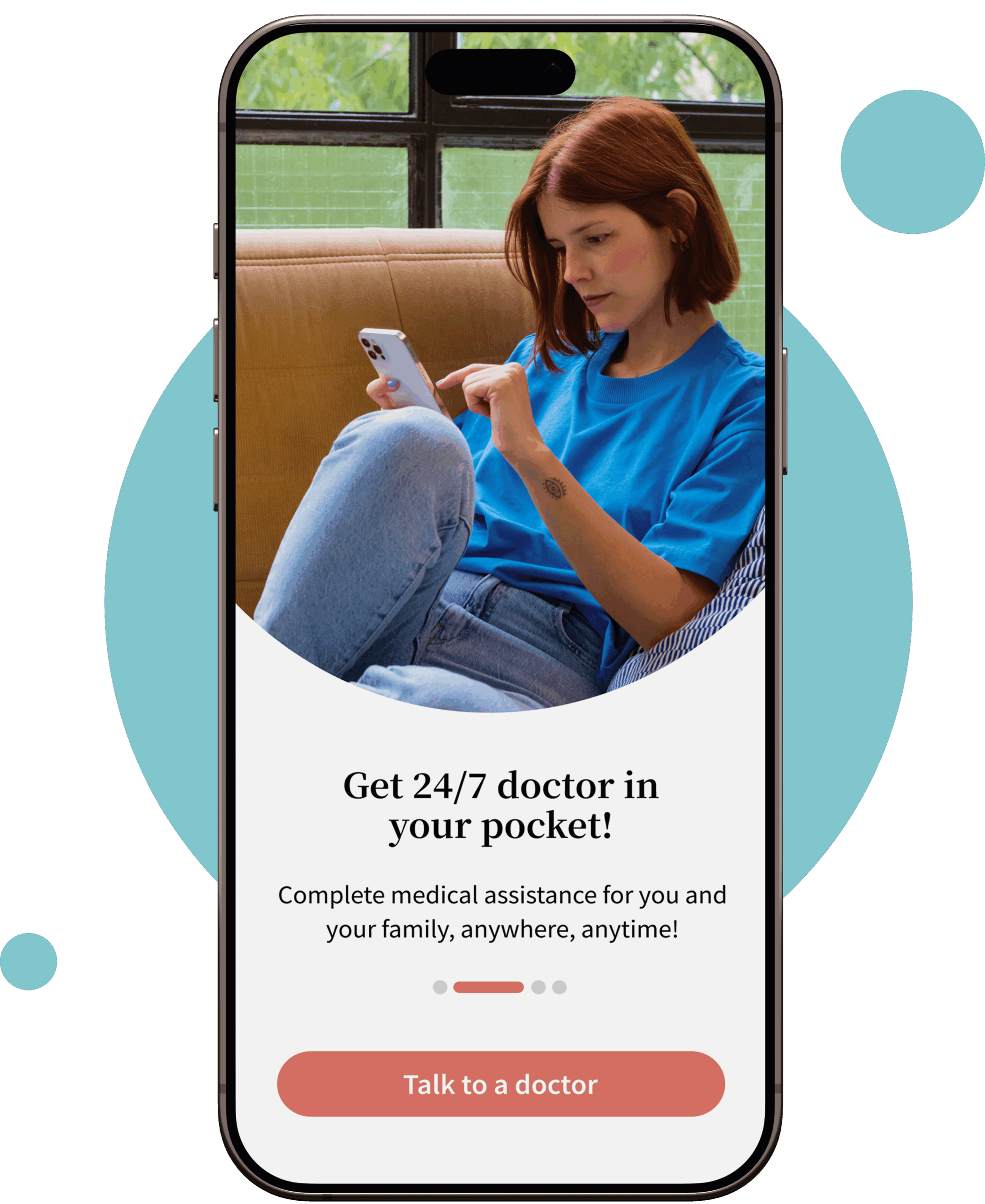
Get a Prescription refill for Doxepin (Silenor) Online
You can get a Doxepin (Silenor) prescription refill for the treatment of anxiety, depression, nerve pain, and insomnia. Doxepin (Silenor) works by increasing certain natural substances in the brain to restore mental balance.
Getting a Doxepin (Silenor) prescription online from us is simple and straightforward. You can simply connect with a doctor at Your Doctors Online from anywhere at any time to discuss your symptoms. However, a Doxepin (Silenor) prescription refill will only be provided after consultation with our doctor and if the treatment is suitable and safe for your needs.
What is Doxepin?
Doxepin (Silenor) is a tricyclic antidepressant medication used for the treatment and management of anxiety, depression, insomnia, neuropathic pain (nerve pain), and itchy skin.
Uses of Doxepin
Doxepin (Silenor) is used for the treatment of mood disorders such as anxiety, depression, manic-depressive disorder, and psychotic depressive disorders. It is also used for sleep disorders such as insomnia and chronic neuropathic pain. In low dosages, it can be used to manage pruritus (itchy skin).
How does it work?
Doxepin works by increasing the levels of certain neurotransmitters in the brain, which can improve mood, sleep, memory, and concentration. It also affects histamine receptors, which makes it effective for treating skin conditions.
How long does Doxepin take to work?
Doxepin (Silenor) can work appropriately after two hours of ingestion. The antidepressant effects of Doxepin (Silenor) can take over two weeks to appear.
The sedative effects for the treatment of anxiety, pain, and insomnia can be observed immediately after administration.
What are the different dosage forms and strengths of doxepin?
Doxepin (Silenor) is available in different dosage forms:
- Capsules (10 mg, 25 mg, 50 mg, 75 mg, 100 mg, and 150 mg)
- Tablets (3mg and 6 mg)
- Oral concentrate (10mg/mL).
For depression and anxiety: Doxepin oral dosage (capsule or solution)
- For adults and children over 12, the starting dose is 75 mg, and it should not be more than 150 mg per day.
- For children under 12, it is not recommended.
For insomnia: Doxepin oral dosage (tablets)
- For adults, 6mg once a day
- For the elderly, 3mg once a day.
- For children over 12 years, the dose is determined by the doctor.
Doxepin (Silenor) doses can differ between patients. Follow your doctor’s guidance or directions on the label. Never change your dose or stop taking a medicine without consulting your doctor.
How to take it?
Doxepin (Silenor) should ideally be taken at the same time(s) daily with the dose recommended by your doctor. Oral tablets should be taken via mouth with water, while oral suspension should be made following the directions of the leaflet.
Doxepin should not be taken within 3 hours of a meal and should not be mixed with carbonated drinks or alcoholic beverages. Doxepin (Silenor) should not be discontinued without consulting with a doctor, as it might lead to withdrawal symptoms.
What are the side effects of Doxepin?
Commonly experienced side effects of Doxepin include
- Dry mouth
- Constipation
- Difficulty in passing urine
- Drowsiness
- Blurred vision
Some severe side effects include
- Dizziness
- Headaches
- Vomiting and nausea
- Allergic reaction
- Breathing difficulties
- Skin becoming sensitive to sunlight
- Heartburn
- Bruising or skin rashes
- Yellowing of the skin or eyes
- Shaking
- Stomach and abdominal pain
- Suicidal thoughts
- Worsened depression
How to Connect with an Online Doctor?
Connect with a health care professional online in 3 easy steps.
1
Describe your Issue
Download our app, register and tell us about your medical issue to get started.
- Anxiety
- Anemia
- STD
- UTI
- Skin
- Covid
2
Chat with a Doctor
Connect with a board-certified doctor. You can chat, send pictures and videos.
Hi Dr Nicole, I have depression and difficulty sleeping, and it is really bad. Can I get my Doxepin refill, please?
3
Get Prescription
Our online doctors can help you with your medical issues and give you prescriptions.
Prescription
- Doxepin 25 mg, Once at bed time.
Send Prescription
Precautions and Contraindications
- Share your medical and medication history with your healthcare provider to avoid allergic reactions or unwanted side effects.
- This medication is not safe in pregnancy and has the probability of causing harm to the baby. It causes symptoms of sedation, breathing problems, feeding issues, and low muscle tone in the baby during the third trimester. Discuss the condition with your healthcare provider or pharmacist for a safe alternative.
- This medication has caused infertility in both men and women. Talk to your doctor if you are planning to have children.
- Do not combine other prescription medications, over-the-counter drugs, or herbal or vitamin supplements with doxepin without discussing it with your doctor.
FAQs About Doxepin
Why can't you take doxepin with food?
Doxepin can not be taken with certain foods and beverages since interactions may occur. These interactions can delay the absorption and alter the effectiveness of doxepin and, in severe cases, enhance the adverse side effects, such as drowsiness. It is best to take doxepin on an empty stomach and avoid alcohol, tobacco, and carbonated drinks while taking this medication.
How long does doxepin stay in your system?
Doxepin should stay in your system for 2 to 5.5 days, with a half-life between 8 and 25 hours. When tested, traces of doxepin can be found in your urine for up to 7 days and detected in blood plasma for up to 14 days.
What are the alternatives of doxepin?
Alternatives of doxepin include Trazodone, Ambien, Prozac (fluoxetine), sertraline (Zoloft), venlafaxine (Effexor), and duloxetine (Cymbalta) for treating anxiety and depression. Depending on the patient's condition, your doctor will determine the best alternative choice.
Who should not take doxepin?
Doxepin should not be taken by individuals who have a known allergy to the medication, are currently using or have recently used MAOIs within the past two weeks, or have a history of certain heart conditions, including recent heart attack, heart block, or arrhythmias, as it may adversely affect cardiac function.
What to avoid with doxepin?
Arbutamine, thyroid supplements, and medications with central actions (such as clonidine and guanabenz) used to treat high blood pressure are some drugs that should be avoided with this medication. This medication may interact negatively (and even fatally) with MAO inhibitors.
What happens if I miss a dose of doxepin?
If you miss a dose, doxepin should be taken as soon as you remember. If your next dose is due, omit the missed one and return to your regular dosing plan. Avoid taking two doses to make up for one you missed, as this can cause more negative effects.
Is Doxepin discontinued?
No, doxepin (Silenor) has not been discontinued. Only the doxepin under the brand name Sinequan was discontinued. The FDA approved it for use to treat anxiety and depression, but it was later discontinued due to worsening side effects, heart problems, and death in some patients.
-Phindile Mkhatshwa
-brooke snow
-Okiti Stephanie
-ASIF Khan
-Chelsey
-edith bien aime
-Lesego Thejane
-Stephanie Brown
-kulwinder gill
-Elijah Mark
Get Started Today
Talk to online doctors now and get medical advice, online prescriptions, and referrals within minutes. On-demand healthcare services at your fingertips.





